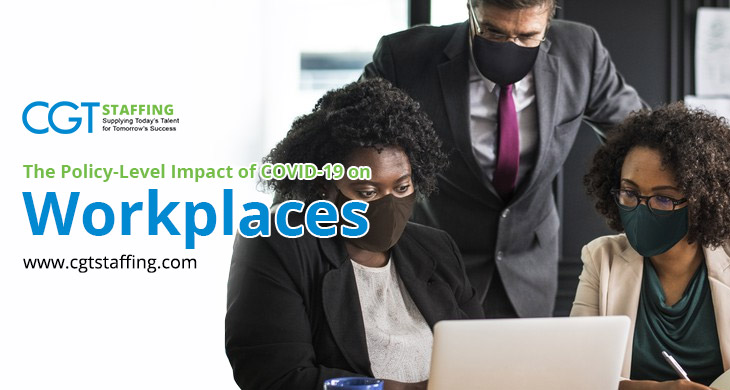Being an entrepreneur, business leader, or corporate manager is never easy. Business landscapes are not static. They have become fluid and frequently have complex cause-and-effect ripples across all industries and sectors. Workforce management is increasingly structured to improve the efficiency of talent acquisition and employee retention policies.
With the global economy being sensitive to any number of variables, the COVID-19 pandemic was something very few disaster management policies accounted for. This highlights a huge gap in the estimations and expectations of business continuity and the scope of the variables they account for. In other words, most businesses were caught unawares, and with no formal policy to deal with this situation.
Table of Contents
COVID-19 Forcing Changes in Workplace Policies
The scale of the COVID-19 pandemic triggered a series of domino-like collapses across countries all over the world. Unemployment rates in 2020 were an economist’s nightmare. Business models that had been functional for decades suddenly became incompatible with the pandemic-forced situation.
If it weren’t for existing digital technology and massive internet penetration across the world, many more businesses would have had to file for bankruptcy than the ones that already did. Even so, only the most agile businesses were able to adapt to and even thrive under these changing conditions. Incidentally, many of these were businesses that were able to hammer out bare-bones but functional policies under the new normal.
The broader workplace policies seeing change are related to employee health and safety, medical leaves and reimbursements, and remote working. But there are many nuanced complexities as well, such as ensuring performance during remote working, managing increased cybersecurity risks, and ensuring device access to key information outside your business information systems.
You may also be concerned with ensuring third parties like your staffing agency are able to meet entirely new staffing gaps, such as a VCISO consultancy. One can argue that lean and agile businesses are most likely to make it past the tough challenges ahead. However, even the best business needs a blueprint or guiding document, and workplace policies usually supply that. Yours may also need to be refined and updated following the pandemic, especially concerning:
Reducing the Health Risks to Your Workforce
The highest priority policy change will usually concern ensuring worker safety. This can be an extension of your Health and Safety policy or an overlap between workforce management and workplace management policies. The concern here would be to identify weaknesses that could threaten employee health or safety and take the necessary steps to reduce the health risks to your workers.
Ensuring the Availability and Use of Protective Equipment
Employee health and safety policies could also require an update in terms of sanitation and the availability of protective equipment. All businesses should encourage employees to stick to the known protective measures that work so far. But they should also make efforts to make the basics like masks, face shields, and protective attire available across the workplace. Don’t depend on your workers to bring their own PPE in every instance. Ensure you have your own supply, and enforce the use of this supply as well.
Developing Protocols for Identifying and Reporting Symptoms
The pandemic is not going away overnight, but businesses will ultimately have to resume on-site work again. Therefore, despite your best policy changes and concerted efforts, infected workers will remain a real risk.
However, policymakers may need to update their protocols and create controls or reporting flows for identifying and/or reporting possible COVID-19 symptoms. Remember, COVID-19 infections can spread rapidly, and your employee turnover could see a significant spike with just one unreported case.
Adapting Leave Policies to Meet New FMLA Guidelines
If one or more of your workers do contract a COVID-19 infection, it can certainly be a cause for serious concern. But empathic managers understand that it can be far more serious for the infected person. You can’t realistically or safely expect them to come into work, especially with severe symptoms. Even asymptomatic workers will infect others. Therefore, you need to reevaluate your paid leave policies, especially under the recent changes to the FMLA.
The Family and Medical Leave Act is a set of federal labor laws that guarantee time off for the American workforce. It n clearly outlines the instances by which an employer is legally mandated to offer paid time off during the pandemic. Leave policies not complying with these rules could result in serious legal consequences.
Realigning Medical Policies with COVID-19 Testing and Treatment
With a pandemic in full force, it is inevitable that medical considerations will remain at an all-time high. All aspects of the medical industry, from frontline workers to support staff to even medical staffing agencies, are seeing unprecedented disruption.
Times may be tough, but you need to realign your medical policies, such as medical coverage, reimbursement, and family coverage in view of the pandemic. This will usually be an update to your existing medical policy. You should also consult your insurance provider, especially if health insurance is a big component of your worker compensation and benefits mix.
Boosting and Maintaining Workforce Morale
Workforce motivation has never been more crucial than it is today. Therefore, your team management policies need to be reviewed. This can include a complete overhaul of team workflows, communication protocols, systems and tools, and even BYOD policies. But it should also include a core component of keeping the workforce motivated.
The extensive physical and mental impact of work stress is now doubled with the stress of catching an infection, having to pay sizeable medical bills, and possibly losing a job in the event of an extended infection. Good managers will already be working towards keeping workers and teams motivated. But you may require broad and sweeping policy-level changes to ensure all managers have guidelines and uniform direction.
